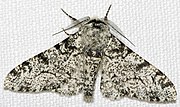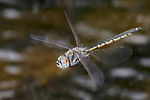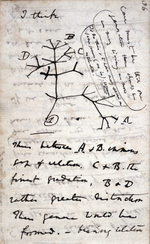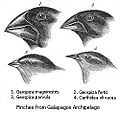understanding of the evolution of insects is based on studies of the following branches of science: molecular biology, insect morphology, paleontology, insect taxonomy...
99 KB (12,169 words) - 22:20, 15 November 2024
Arthropod leg (redirect from Insect trochanter)
Galis, Frietson (1996). "The evolution of insects and vertebrates: homeobox genes and homology". Trends in Ecology & Evolution. 11 (10): 402–403. doi:10...
26 KB (2,924 words) - 04:33, 5 August 2024
Insects (from Latin insectum) are hexapod invertebrates of the class Insecta. They are the largest group within the arthropod phylum. Insects have a chitinous...
134 KB (12,787 words) - 00:37, 7 October 2024
Metamorphosis (redirect from Evolution of metamorphosis in insects)
as adults. The earliest insect forms showed direct development (ametabolism), and the evolution of metamorphosis in insects is thought to have fuelled...
23 KB (2,677 words) - 17:03, 18 November 2024
of those groups. The cladistic term for the same phenomenon is homoplasy. The recurrent evolution of flight is a classic example, as flying insects,...
57 KB (5,772 words) - 13:33, 4 November 2024
The evolution of the peppered moth is an evolutionary instance of directional colour change in the moth population as a consequence of air pollution during...
40 KB (4,522 words) - 06:41, 24 October 2024
Semelparity and iteroparity (redirect from Evolution of semelparity)
Fritz, Stamp & Halverson (1982) define semelparous insects as "insects that lay a single clutch of eggs in their lifetime and deposit them at one place...
37 KB (4,493 words) - 20:33, 19 October 2024
Phanerozoic (section Eras of the Phanerozoic)
diverse forms; the evolution of plants; the evolution of fish, arthropods and molluscs; the terrestrial colonization and evolution of insects, chelicerates...
61 KB (6,170 words) - 14:37, 7 November 2024
Eusociality (redirect from Social Insects)
(2003). "The ecology and evolution of eusociality in sponge-dwelling shrimp". Genes, Behaviors and Evolution of Social Insects: 217–254. Duffy, J. E.;...
68 KB (7,531 words) - 18:59, 4 November 2024
Meganisoptera (redirect from Giant Insects)
that insects really do breathe, with "rapid cycles of tracheal compression and expansion". Recent analysis of the flight energetics of modern insects and...
13 KB (1,413 words) - 17:56, 6 August 2024
Insects are the only group of invertebrates that have evolved wings and flight. Insects first flew in the Carboniferous, some 300 to 350 million years...
65 KB (8,499 words) - 18:41, 18 October 2024
classification of the butterflies (Lepidoptera: Papilionidea). Kansas Univ. Sci. Bull., 39, 305-370. Grimaldi, D. & Engel, M. S. 2005. Evolution of the insects. Cambridge:...
7 KB (743 words) - 21:39, 4 November 2024
Sex (section Evolution of sex)
OCLC 703739906. Kaiser VB, Bachtrog D (2010). "Evolution of sex chromosomes in insects". Annual Review of Genetics. 44: 91–112. doi:10.1146/annurev-genet-102209-163600...
66 KB (7,711 words) - 03:06, 23 November 2024
Mesozoic (redirect from The Age of the Dinosaurs)
Acta 70, 5653–64. See the dotted line in Fig. 1 of Atmospheric oxygen level and the evolution of insect body size by Jon F. Harrison, Alexander Kaiser...
41 KB (4,341 words) - 21:17, 19 November 2024
Sodium–potassium pump (section The parallel evolution of resistance to cardiotonic steroids in many vertebrates)
fertility. Insects have at least one copy of both genes, and occasionally duplications. Low expression of ATPα2 has also been noted in other insects. Duplications...
38 KB (4,367 words) - 14:01, 27 October 2024
Proleg (redirect from Crochet (insect anatomy))
ventral surface of the abdomen of most larval forms of insects of the order Lepidoptera, though they can also be found on larvae of insects such as sawflies...
5 KB (319 words) - 02:43, 20 January 2024
Insect wings are adult outgrowths of the insect exoskeleton that enable insects to fly. They are found on the second and third thoracic segments (the...
94 KB (11,615 words) - 02:25, 9 October 2024
Evolution is the change in the heritable characteristics of biological populations over successive generations. It occurs when evolutionary processes...
240 KB (24,900 words) - 03:29, 23 November 2024
Entomophagy (redirect from Eating of insects)
(/ˌɛntəˈmɒfədʒi/, from Greek ἔντομον éntomon, 'insect', and φαγεῖν phagein, 'to eat') is the practice of eating insects. An alternative term is insectivory. Terms...
10 KB (890 words) - 13:16, 3 December 2023
Larva (redirect from Insect larvae)
inactive as of November 2024 (link) Nagy, Lisa M.; Grbić, Miodrag (1999), "Cell Lineages in Larval Development and Evolutions of Holometabolous Insects", The...
15 KB (1,378 words) - 09:41, 2 November 2024
Holometabolism (category Insect developmental biology)
of insect development which includes four life stages: egg, larva, pupa, and imago (or adult). Holometabolism is a synapomorphic trait of all insects...
22 KB (2,635 words) - 03:51, 21 July 2024
Plant defense against herbivory (redirect from Plant resistance to insects)
Historically, insects have been the most significant herbivores, and the evolution of land plants is closely associated with the evolution of insects. While...
94 KB (10,727 words) - 16:59, 24 November 2024
Arthropod (redirect from Evolution of arthropods)
blood-sucking insects. Other blood-sucking insects infect livestock with diseases that kill many animals and greatly reduce the usefulness of others. Ticks...
131 KB (12,537 words) - 00:54, 25 November 2024
Coevolution (redirect from Co-evolution)
plants and insects in On the Origin of Species (1859). Although he did not use the word coevolution, he suggested how plants and insects could evolve...
49 KB (5,377 words) - 07:32, 29 October 2024
Insects have mouthparts that may vary greatly across insect species, as they are adapted to particular modes of feeding. The earliest insects had chewing...
16 KB (1,834 words) - 01:23, 11 August 2024
Sexual reproduction (redirect from Sexual reproduction in insects)
of both sexes. However, individuals of most species remain of one sex their entire lives. A few species of insects and crustaceans can reproduce by parthenogenesis...
39 KB (4,831 words) - 14:41, 2 November 2024
Entomology (redirect from List of works of higher classification of insects)
ἔντομον (entomon) 'insect' and -λογία (-logia) 'study') is the scientific study of insects, a branch of zoology. In the past the term insect was less specific...
28 KB (2,728 words) - 22:00, 24 November 2024
are similar. An example of convergent evolution is the development of flight in birds, bats, and insects, all of which are not closely related but share...
15 KB (1,654 words) - 23:02, 17 October 2024
Feliformia (redirect from Evolution of feliform mammals)
species feeding on insects or invertebrates). An overview of each family is provided here. For detailed taxa and descriptions of the species in each...
22 KB (2,177 words) - 00:19, 19 November 2024
Phasmatodea (redirect from Stick insects)
as Phasmida or Phasmatoptera) are an order of insects whose members are variously known as stick insects, stick bugs, walkingsticks, stick animals, or...
53 KB (6,048 words) - 19:42, 19 November 2024























